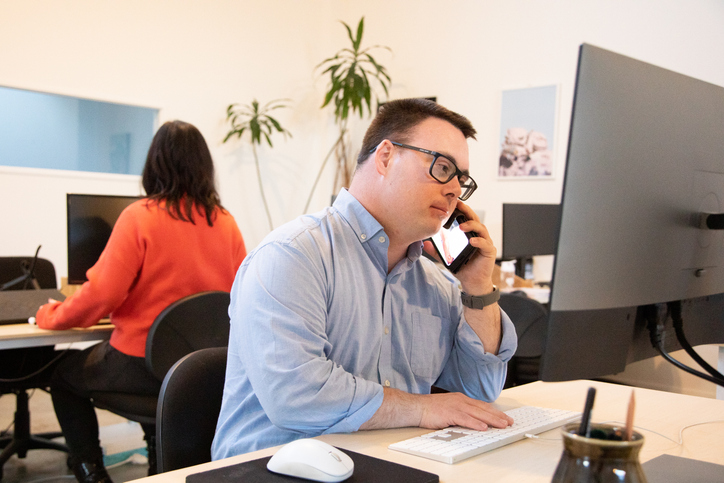As more companies return to the office, either on a part- or full-time basis, facilities managers should work with employers to modify the workplace so neurodivergent employees are given equal opportunities to succeed.

What Does Being ‘Neurodivergent’ Mean?
According to the Cleveland Clinic, “neurodivergent” is a nonmedical term describing people whose “brains develop or work differently for some reason. This means the person has different strengths and struggles from people whose brains develop or work more typically.”
While some neurodivergent individuals have medical conditions, the clinic notes that others have an unidentified medical condition or diagnosis.
Some of the conditions that are most common among those who are considered neurodivergent include:
- Autism spectrum disorder (includes what was once known as Asperger’s syndrome)
- Attention-deficit/hyperactivity disorder (ADHD)
- Down syndrome
- Dyscalculia (difficulty with math)
- Dysgraphia (difficulty with writing)
- Dyslexia (difficulty with reading)
- Dyspraxia (difficulty with coordination)
- Intellectual disabilities
- Mental health conditions like bipolar disorder, obsessive-compulsive disorder, and more
- Prader-Willi syndrome
- Sensory processing disorders
- Social anxiety (a type of anxiety disorder)
- Tourette syndrome
- Williams syndrome
Research shows that 15% to 20% of the U.S. population is neurodivergent, according to the Employer Assistance and Resource Network on Disability Inclusion (EARN).
Here are five ways facilities managers could redesign their facilities to meet the needs of neurodivergent employees:
1. Light and Color
According to Fast Company, many neurodivergent people, especially those with ADHD, are sensitive to bright and unnatural lighting. So, consider adding windows or skylights for natural light, but if that isn’t possible, think about purchasing soft light-emitting diode (LED) lighting with adjustable settings, shiny furniture, and mirrors. To learn more about making lighting improvements, check out “Back to Basics: Lighting Improvements for Healthy Buildings” on Facilities Management Advisor. Additionally, Aimee Collins, a design principal at global design consultancy firm Unispace, told Inc. that workspaces should use neutral tones like beige, taupe, cream, and gray rather than bright colors.
2. Soundproofing
Those who are neurodivergent may find it difficult to stay focused and work in a noisy office, so Inc. recommends converting unused private offices into general-use spaces for employees who need a quiet place to work. Also, consider carpeting and furnishing areas with soundproof furniture like egg pod chairs to enhance the acoustics and play calm music to encourage meditation, as well as other possible design changes to walls and ceilings. As Collins noted, “With dropped ceilings, you can have that sound absorption at a level that allows for a quieter space.”
3. Indoor Air Quality (IAQ)
For those with hyperosmia, or a sensitivity to smell that can trigger migraines, nausea, anxiety, and depression, or with neurogenic olfactory sensitivities, like those with autism, Fast Company recommends purchasing cleaning products without fragrance and investing in high-performance heating, ventilation, and air conditioning (HVAC) equipment, including IAQ technology that can clean and filter the air. For effective natural air purifiers, consider adding a biophilic design to the workspace, and to learn more, read “How Facilities Can Improve Their Air Quality” and “Incorporating a Biophilic Design into Your Facilities” on Facilities Management Advisor.
4. Work Environments
Your facility should have several types of spaces employees can choose from. The International Facility Management Association (IFMA) recommends having some areas with limited décor to provide a peaceful environment for concentration, while Fast Company advises limiting higher levels of stimuli, with color and textures, to larger rooms where groups can work together. Also, provide private rooms that could include a couch and a yoga mat employees can use as recharging stations, and consider allowing employees to personalize their space with personal belongings like photos to make them feel more comfortable. Additionally, offer areas with transparent glass walls, rooms with solid walls and doors that can be closed, and areas with spatial dividers that reduce distractions so employees can choose where they work best.
5. Layout
Workers with cognitive challenges, like dyslexia, might get lost in places where everything looks similar because they typically rely on environmental cues to orient themselves, Fast Company notes. As such, facilities managers would be wise to create unique spaces that have visual landmarks and clear lines of sight to exit doors and circulation paths. Additionally, consider having lower ceilings near the entrance to make the main part of the office that has higher ceilings seem larger, and incorporate different types of art, architecture, and other design elements into the layout of the workspace.
Allow All to Succeed
Neurodivergent employees bring valuable skills and talents to the workplace, so it’s worth making appropriate accommodations for these workers so they can be as productive as possible. For more helpful tips, check out “Including Neurodivergent Workers: Workspace, Work Schedules, and Other Accommodations,” written by EARN.
Whether facilities managers have neurodivergent employees or not, modifications to light and color, soundproofing, air quality, work environments, and layout can help everyone succeed.
